Organizational Change Management: Problems & Solutions Essay
VerifiedAdded on 2023/04/11
|11
|3734
|111
Essay
AI Summary
This essay provides a comprehensive analysis of the challenges inherent in organizational change management from the perspectives of both leaders and managers. It begins by differentiating between leadership and management, highlighting the complementary roles each plays in achieving organizational goals. The essay explores how leaders and managers differ in their approaches, responsibilities, and qualities, and examines various leadership styles and management theories. It delves into the problematic aspects of change management, focusing on the resistance that often arises and the difficulties in implementing new strategies. Furthermore, the essay discusses several methods that leaders and managers can employ to overcome this resistance, foster a culture of acceptance, and ensure the successful implementation of organizational changes. The essay concludes by emphasizing the importance of both effective leadership and management in navigating the complexities of organizational change and achieving desired outcomes. Desklib offers a variety of study tools, including past papers and solved assignments, to aid students in their understanding of these concepts.

Management
A Leader and manager both play an important role in the organisational development
and for the growth of the organization. There are different views about a leader and a
manager and criticism regarding this topic. It is known that an organization can be
successful if it can rely upon the creativity of the leaders and practicality of managers.
To understand the difference between Leadership and management, it is important to
know the difference between a leader and a manager. A manager is a person who has
the responsibility to manage the group and he is the part of that group too but still
separate from the group. There are only a limited number of managers in an office. A
manager should be a good manager if he can perform his role well and in an
appropriate way. It is the duty of the manager to check day to day tasks and to assure
that everything gets completed on time. They mainly use different rules, regulations,
processes and tactical control to manage overall activities (Mitevska-Encheva, 2018).
Management refers to a process that includes planning, organizing, direction and
controlling activities and it is considered as an art as well as a science (SETHIBE and
STEYN, 2017). Management helps in fulfilment goals and objectives. According to
the definition of management, a manager is defined as a person who is responsible for
planning, organizing, directing the work, monitoring it and take corrective actions in
case of need. On the other hand leadership refers to the development of clear system if
expectations that helps in identifying the utilization if organizational resources like
people so leader is defined as a person involved into persuading people to know what
they are supposed to do and what not. Leadership can easily transforms anything by
making it a reality and it can’t replace management but can be a part of it
(Zydziunaite, Lepaite and Suominen, 2013).
There are differences between a manager and a leader and the reason for the same are
the conceptions they hold. Leaders and managers are complementary to each other
and both of them play and important role in achieving the goals and objectives. In this
essay, all the differences between leaders and managers are stated by defining,
comparing and contrasting different rules, responsibilities, qualities, leadership styles
and management theories (Mitevska-Encheva, 2018).
A Leader and manager both play an important role in the organisational development
and for the growth of the organization. There are different views about a leader and a
manager and criticism regarding this topic. It is known that an organization can be
successful if it can rely upon the creativity of the leaders and practicality of managers.
To understand the difference between Leadership and management, it is important to
know the difference between a leader and a manager. A manager is a person who has
the responsibility to manage the group and he is the part of that group too but still
separate from the group. There are only a limited number of managers in an office. A
manager should be a good manager if he can perform his role well and in an
appropriate way. It is the duty of the manager to check day to day tasks and to assure
that everything gets completed on time. They mainly use different rules, regulations,
processes and tactical control to manage overall activities (Mitevska-Encheva, 2018).
Management refers to a process that includes planning, organizing, direction and
controlling activities and it is considered as an art as well as a science (SETHIBE and
STEYN, 2017). Management helps in fulfilment goals and objectives. According to
the definition of management, a manager is defined as a person who is responsible for
planning, organizing, directing the work, monitoring it and take corrective actions in
case of need. On the other hand leadership refers to the development of clear system if
expectations that helps in identifying the utilization if organizational resources like
people so leader is defined as a person involved into persuading people to know what
they are supposed to do and what not. Leadership can easily transforms anything by
making it a reality and it can’t replace management but can be a part of it
(Zydziunaite, Lepaite and Suominen, 2013).
There are differences between a manager and a leader and the reason for the same are
the conceptions they hold. Leaders and managers are complementary to each other
and both of them play and important role in achieving the goals and objectives. In this
essay, all the differences between leaders and managers are stated by defining,
comparing and contrasting different rules, responsibilities, qualities, leadership styles
and management theories (Mitevska-Encheva, 2018).
Paraphrase This Document
Need a fresh take? Get an instant paraphrase of this document with our AI Paraphraser
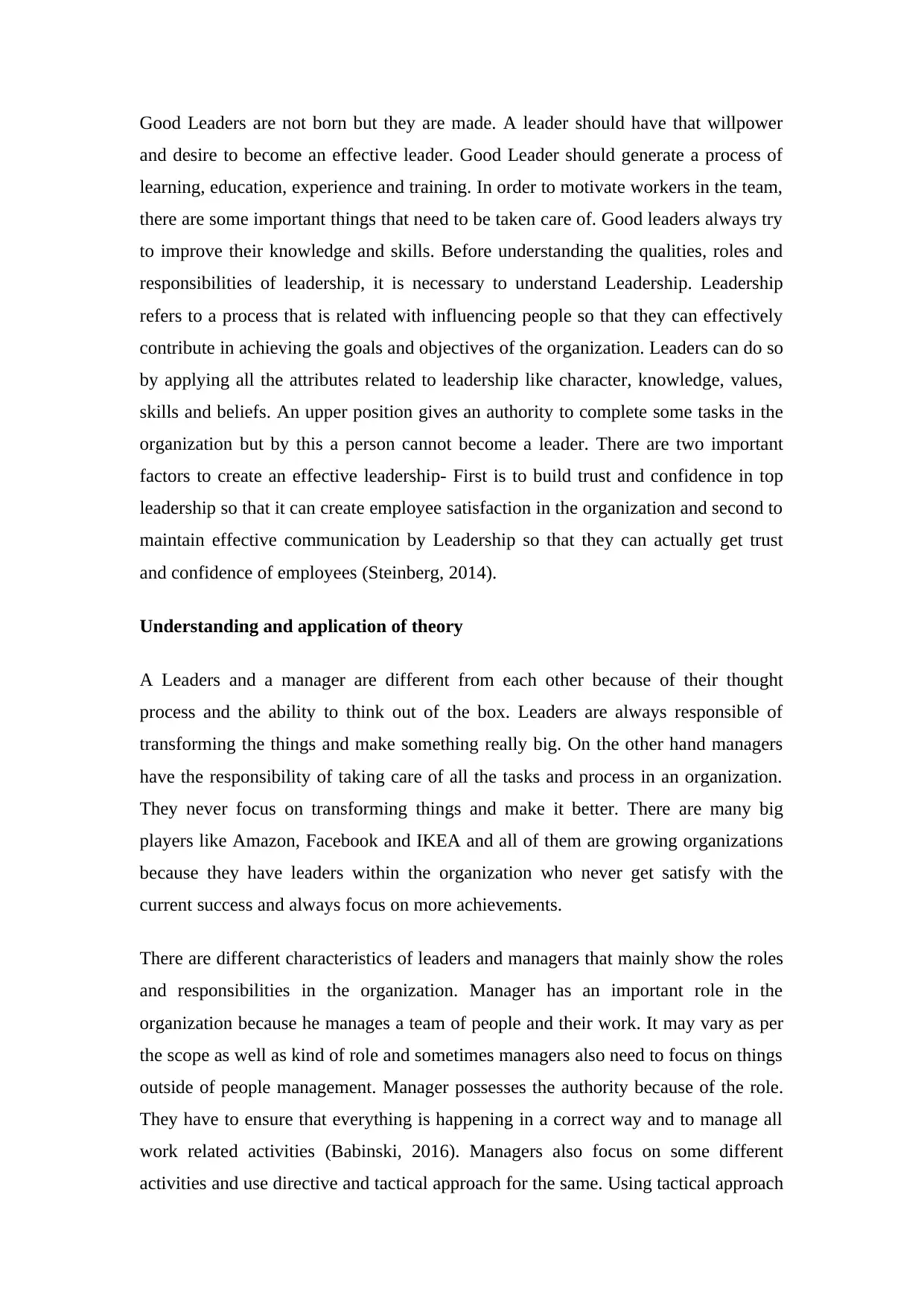
Good Leaders are not born but they are made. A leader should have that willpower
and desire to become an effective leader. Good Leader should generate a process of
learning, education, experience and training. In order to motivate workers in the team,
there are some important things that need to be taken care of. Good leaders always try
to improve their knowledge and skills. Before understanding the qualities, roles and
responsibilities of leadership, it is necessary to understand Leadership. Leadership
refers to a process that is related with influencing people so that they can effectively
contribute in achieving the goals and objectives of the organization. Leaders can do so
by applying all the attributes related to leadership like character, knowledge, values,
skills and beliefs. An upper position gives an authority to complete some tasks in the
organization but by this a person cannot become a leader. There are two important
factors to create an effective leadership- First is to build trust and confidence in top
leadership so that it can create employee satisfaction in the organization and second to
maintain effective communication by Leadership so that they can actually get trust
and confidence of employees (Steinberg, 2014).
Understanding and application of theory
A Leaders and a manager are different from each other because of their thought
process and the ability to think out of the box. Leaders are always responsible of
transforming the things and make something really big. On the other hand managers
have the responsibility of taking care of all the tasks and process in an organization.
They never focus on transforming things and make it better. There are many big
players like Amazon, Facebook and IKEA and all of them are growing organizations
because they have leaders within the organization who never get satisfy with the
current success and always focus on more achievements.
There are different characteristics of leaders and managers that mainly show the roles
and responsibilities in the organization. Manager has an important role in the
organization because he manages a team of people and their work. It may vary as per
the scope as well as kind of role and sometimes managers also need to focus on things
outside of people management. Manager possesses the authority because of the role.
They have to ensure that everything is happening in a correct way and to manage all
work related activities (Babinski, 2016). Managers also focus on some different
activities and use directive and tactical approach for the same. Using tactical approach
and desire to become an effective leader. Good Leader should generate a process of
learning, education, experience and training. In order to motivate workers in the team,
there are some important things that need to be taken care of. Good leaders always try
to improve their knowledge and skills. Before understanding the qualities, roles and
responsibilities of leadership, it is necessary to understand Leadership. Leadership
refers to a process that is related with influencing people so that they can effectively
contribute in achieving the goals and objectives of the organization. Leaders can do so
by applying all the attributes related to leadership like character, knowledge, values,
skills and beliefs. An upper position gives an authority to complete some tasks in the
organization but by this a person cannot become a leader. There are two important
factors to create an effective leadership- First is to build trust and confidence in top
leadership so that it can create employee satisfaction in the organization and second to
maintain effective communication by Leadership so that they can actually get trust
and confidence of employees (Steinberg, 2014).
Understanding and application of theory
A Leaders and a manager are different from each other because of their thought
process and the ability to think out of the box. Leaders are always responsible of
transforming the things and make something really big. On the other hand managers
have the responsibility of taking care of all the tasks and process in an organization.
They never focus on transforming things and make it better. There are many big
players like Amazon, Facebook and IKEA and all of them are growing organizations
because they have leaders within the organization who never get satisfy with the
current success and always focus on more achievements.
There are different characteristics of leaders and managers that mainly show the roles
and responsibilities in the organization. Manager has an important role in the
organization because he manages a team of people and their work. It may vary as per
the scope as well as kind of role and sometimes managers also need to focus on things
outside of people management. Manager possesses the authority because of the role.
They have to ensure that everything is happening in a correct way and to manage all
work related activities (Babinski, 2016). Managers also focus on some different
activities and use directive and tactical approach for the same. Using tactical approach
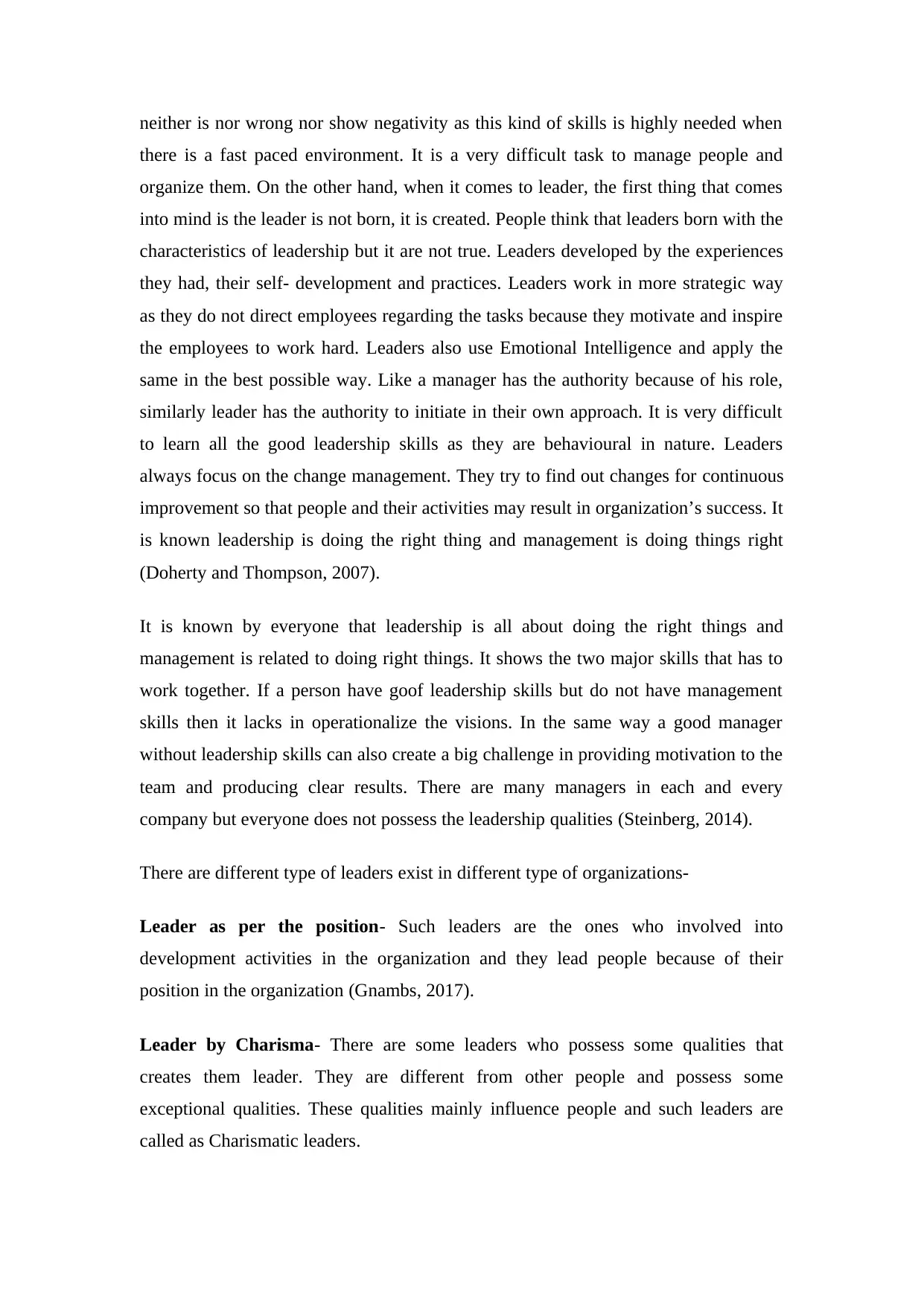
neither is nor wrong nor show negativity as this kind of skills is highly needed when
there is a fast paced environment. It is a very difficult task to manage people and
organize them. On the other hand, when it comes to leader, the first thing that comes
into mind is the leader is not born, it is created. People think that leaders born with the
characteristics of leadership but it are not true. Leaders developed by the experiences
they had, their self- development and practices. Leaders work in more strategic way
as they do not direct employees regarding the tasks because they motivate and inspire
the employees to work hard. Leaders also use Emotional Intelligence and apply the
same in the best possible way. Like a manager has the authority because of his role,
similarly leader has the authority to initiate in their own approach. It is very difficult
to learn all the good leadership skills as they are behavioural in nature. Leaders
always focus on the change management. They try to find out changes for continuous
improvement so that people and their activities may result in organization’s success. It
is known leadership is doing the right thing and management is doing things right
(Doherty and Thompson, 2007).
It is known by everyone that leadership is all about doing the right things and
management is related to doing right things. It shows the two major skills that has to
work together. If a person have goof leadership skills but do not have management
skills then it lacks in operationalize the visions. In the same way a good manager
without leadership skills can also create a big challenge in providing motivation to the
team and producing clear results. There are many managers in each and every
company but everyone does not possess the leadership qualities (Steinberg, 2014).
There are different type of leaders exist in different type of organizations-
Leader as per the position- Such leaders are the ones who involved into
development activities in the organization and they lead people because of their
position in the organization (Gnambs, 2017).
Leader by Charisma- There are some leaders who possess some qualities that
creates them leader. They are different from other people and possess some
exceptional qualities. These qualities mainly influence people and such leaders are
called as Charismatic leaders.
there is a fast paced environment. It is a very difficult task to manage people and
organize them. On the other hand, when it comes to leader, the first thing that comes
into mind is the leader is not born, it is created. People think that leaders born with the
characteristics of leadership but it are not true. Leaders developed by the experiences
they had, their self- development and practices. Leaders work in more strategic way
as they do not direct employees regarding the tasks because they motivate and inspire
the employees to work hard. Leaders also use Emotional Intelligence and apply the
same in the best possible way. Like a manager has the authority because of his role,
similarly leader has the authority to initiate in their own approach. It is very difficult
to learn all the good leadership skills as they are behavioural in nature. Leaders
always focus on the change management. They try to find out changes for continuous
improvement so that people and their activities may result in organization’s success. It
is known leadership is doing the right thing and management is doing things right
(Doherty and Thompson, 2007).
It is known by everyone that leadership is all about doing the right things and
management is related to doing right things. It shows the two major skills that has to
work together. If a person have goof leadership skills but do not have management
skills then it lacks in operationalize the visions. In the same way a good manager
without leadership skills can also create a big challenge in providing motivation to the
team and producing clear results. There are many managers in each and every
company but everyone does not possess the leadership qualities (Steinberg, 2014).
There are different type of leaders exist in different type of organizations-
Leader as per the position- Such leaders are the ones who involved into
development activities in the organization and they lead people because of their
position in the organization (Gnambs, 2017).
Leader by Charisma- There are some leaders who possess some qualities that
creates them leader. They are different from other people and possess some
exceptional qualities. These qualities mainly influence people and such leaders are
called as Charismatic leaders.
⊘ This is a preview!⊘
Do you want full access?
Subscribe today to unlock all pages.

Trusted by 1+ million students worldwide
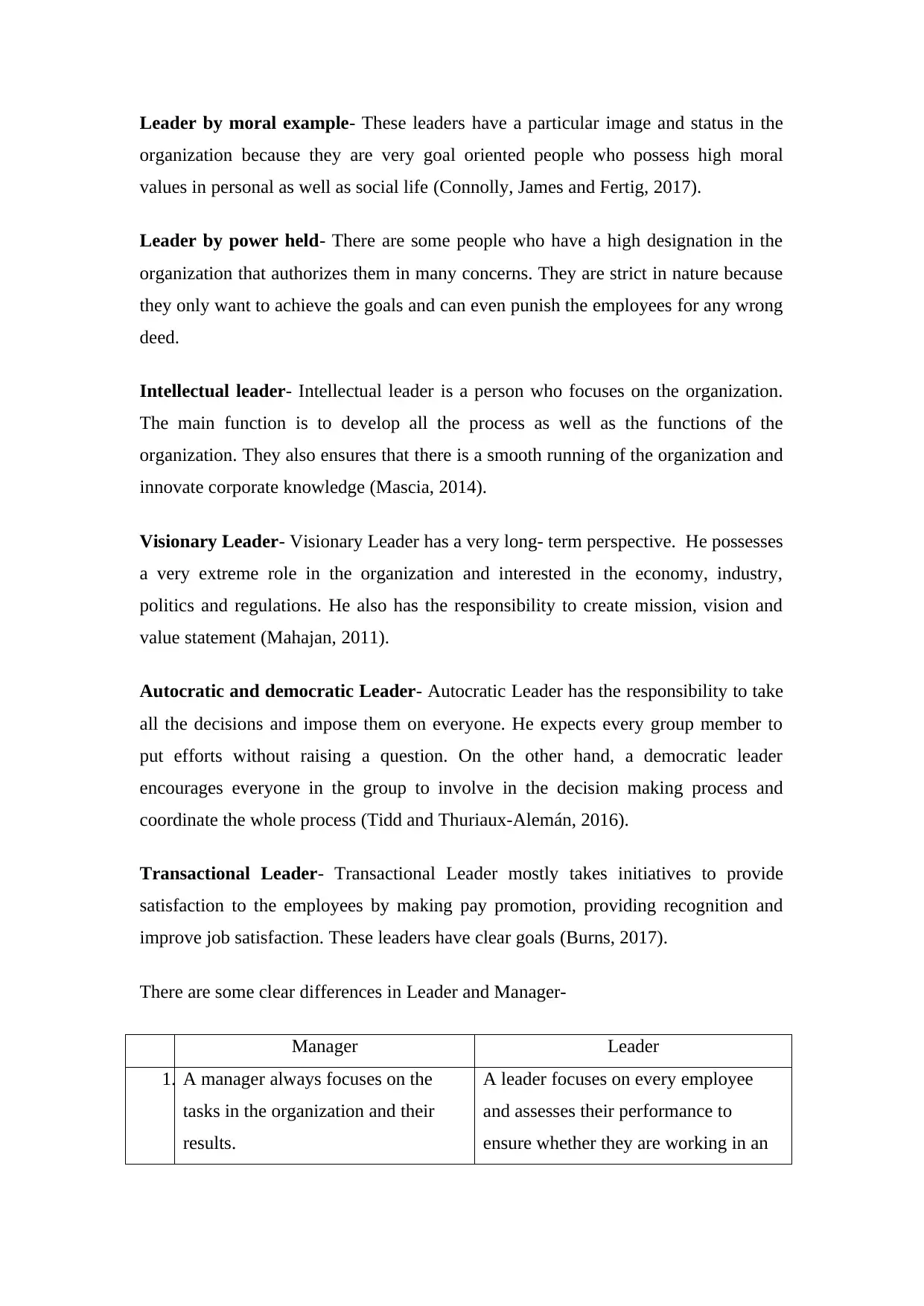
Leader by moral example- These leaders have a particular image and status in the
organization because they are very goal oriented people who possess high moral
values in personal as well as social life (Connolly, James and Fertig, 2017).
Leader by power held- There are some people who have a high designation in the
organization that authorizes them in many concerns. They are strict in nature because
they only want to achieve the goals and can even punish the employees for any wrong
deed.
Intellectual leader- Intellectual leader is a person who focuses on the organization.
The main function is to develop all the process as well as the functions of the
organization. They also ensures that there is a smooth running of the organization and
innovate corporate knowledge (Mascia, 2014).
Visionary Leader- Visionary Leader has a very long- term perspective. He possesses
a very extreme role in the organization and interested in the economy, industry,
politics and regulations. He also has the responsibility to create mission, vision and
value statement (Mahajan, 2011).
Autocratic and democratic Leader- Autocratic Leader has the responsibility to take
all the decisions and impose them on everyone. He expects every group member to
put efforts without raising a question. On the other hand, a democratic leader
encourages everyone in the group to involve in the decision making process and
coordinate the whole process (Tidd and Thuriaux-Alemán, 2016).
Transactional Leader- Transactional Leader mostly takes initiatives to provide
satisfaction to the employees by making pay promotion, providing recognition and
improve job satisfaction. These leaders have clear goals (Burns, 2017).
There are some clear differences in Leader and Manager-
Manager Leader
1. A manager always focuses on the
tasks in the organization and their
results.
A leader focuses on every employee
and assesses their performance to
ensure whether they are working in an
organization because they are very goal oriented people who possess high moral
values in personal as well as social life (Connolly, James and Fertig, 2017).
Leader by power held- There are some people who have a high designation in the
organization that authorizes them in many concerns. They are strict in nature because
they only want to achieve the goals and can even punish the employees for any wrong
deed.
Intellectual leader- Intellectual leader is a person who focuses on the organization.
The main function is to develop all the process as well as the functions of the
organization. They also ensures that there is a smooth running of the organization and
innovate corporate knowledge (Mascia, 2014).
Visionary Leader- Visionary Leader has a very long- term perspective. He possesses
a very extreme role in the organization and interested in the economy, industry,
politics and regulations. He also has the responsibility to create mission, vision and
value statement (Mahajan, 2011).
Autocratic and democratic Leader- Autocratic Leader has the responsibility to take
all the decisions and impose them on everyone. He expects every group member to
put efforts without raising a question. On the other hand, a democratic leader
encourages everyone in the group to involve in the decision making process and
coordinate the whole process (Tidd and Thuriaux-Alemán, 2016).
Transactional Leader- Transactional Leader mostly takes initiatives to provide
satisfaction to the employees by making pay promotion, providing recognition and
improve job satisfaction. These leaders have clear goals (Burns, 2017).
There are some clear differences in Leader and Manager-
Manager Leader
1. A manager always focuses on the
tasks in the organization and their
results.
A leader focuses on every employee
and assesses their performance to
ensure whether they are working in an
Paraphrase This Document
Need a fresh take? Get an instant paraphrase of this document with our AI Paraphraser
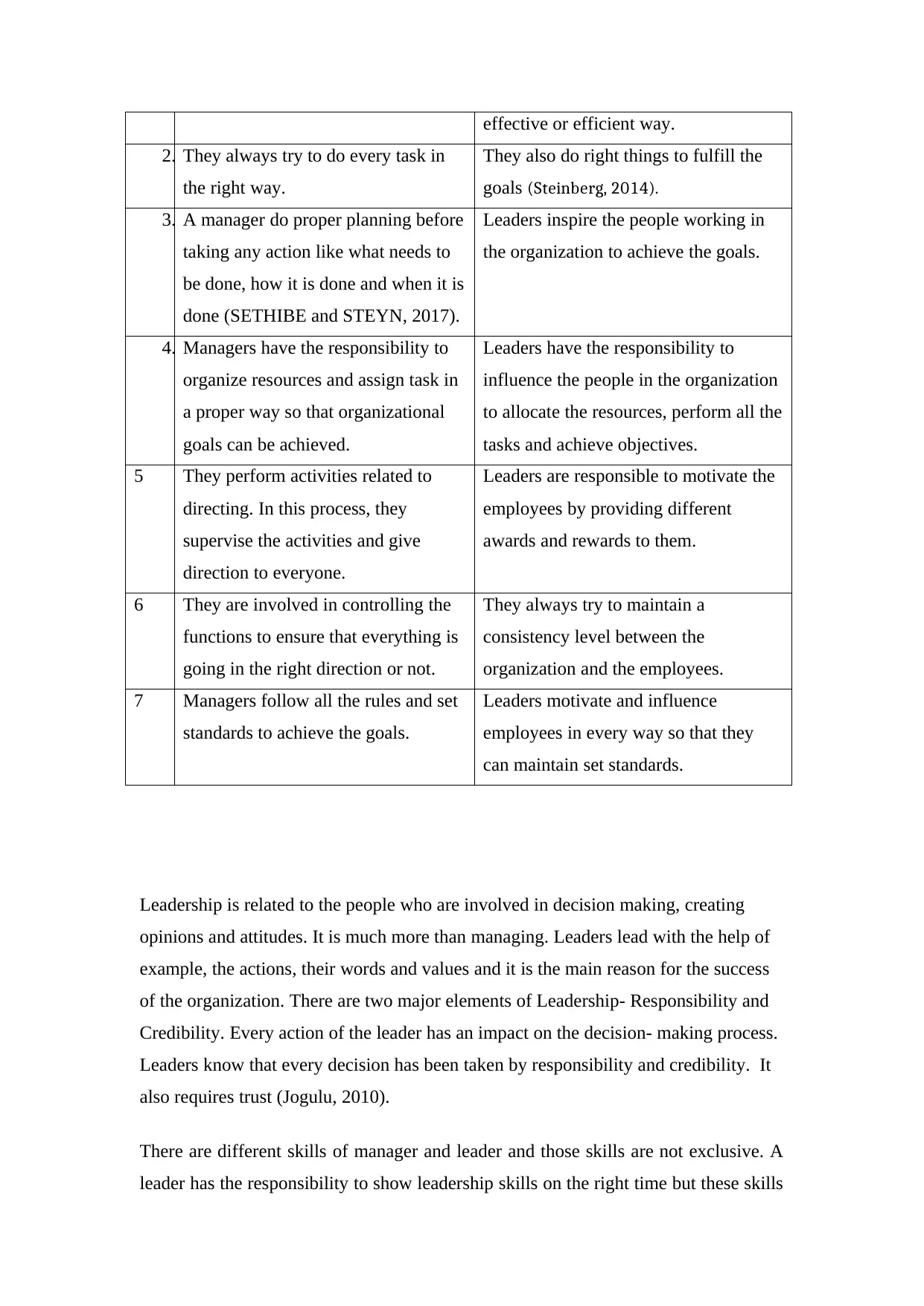
effective or efficient way.
2. They always try to do every task in
the right way.
They also do right things to fulfill the
goals (Steinberg, 2014).
3. A manager do proper planning before
taking any action like what needs to
be done, how it is done and when it is
done (SETHIBE and STEYN, 2017).
Leaders inspire the people working in
the organization to achieve the goals.
4. Managers have the responsibility to
organize resources and assign task in
a proper way so that organizational
goals can be achieved.
Leaders have the responsibility to
influence the people in the organization
to allocate the resources, perform all the
tasks and achieve objectives.
5 They perform activities related to
directing. In this process, they
supervise the activities and give
direction to everyone.
Leaders are responsible to motivate the
employees by providing different
awards and rewards to them.
6 They are involved in controlling the
functions to ensure that everything is
going in the right direction or not.
They always try to maintain a
consistency level between the
organization and the employees.
7 Managers follow all the rules and set
standards to achieve the goals.
Leaders motivate and influence
employees in every way so that they
can maintain set standards.
Leadership is related to the people who are involved in decision making, creating
opinions and attitudes. It is much more than managing. Leaders lead with the help of
example, the actions, their words and values and it is the main reason for the success
of the organization. There are two major elements of Leadership- Responsibility and
Credibility. Every action of the leader has an impact on the decision- making process.
Leaders know that every decision has been taken by responsibility and credibility. It
also requires trust (Jogulu, 2010).
There are different skills of manager and leader and those skills are not exclusive. A
leader has the responsibility to show leadership skills on the right time but these skills
2. They always try to do every task in
the right way.
They also do right things to fulfill the
goals (Steinberg, 2014).
3. A manager do proper planning before
taking any action like what needs to
be done, how it is done and when it is
done (SETHIBE and STEYN, 2017).
Leaders inspire the people working in
the organization to achieve the goals.
4. Managers have the responsibility to
organize resources and assign task in
a proper way so that organizational
goals can be achieved.
Leaders have the responsibility to
influence the people in the organization
to allocate the resources, perform all the
tasks and achieve objectives.
5 They perform activities related to
directing. In this process, they
supervise the activities and give
direction to everyone.
Leaders are responsible to motivate the
employees by providing different
awards and rewards to them.
6 They are involved in controlling the
functions to ensure that everything is
going in the right direction or not.
They always try to maintain a
consistency level between the
organization and the employees.
7 Managers follow all the rules and set
standards to achieve the goals.
Leaders motivate and influence
employees in every way so that they
can maintain set standards.
Leadership is related to the people who are involved in decision making, creating
opinions and attitudes. It is much more than managing. Leaders lead with the help of
example, the actions, their words and values and it is the main reason for the success
of the organization. There are two major elements of Leadership- Responsibility and
Credibility. Every action of the leader has an impact on the decision- making process.
Leaders know that every decision has been taken by responsibility and credibility. It
also requires trust (Jogulu, 2010).
There are different skills of manager and leader and those skills are not exclusive. A
leader has the responsibility to show leadership skills on the right time but these skills
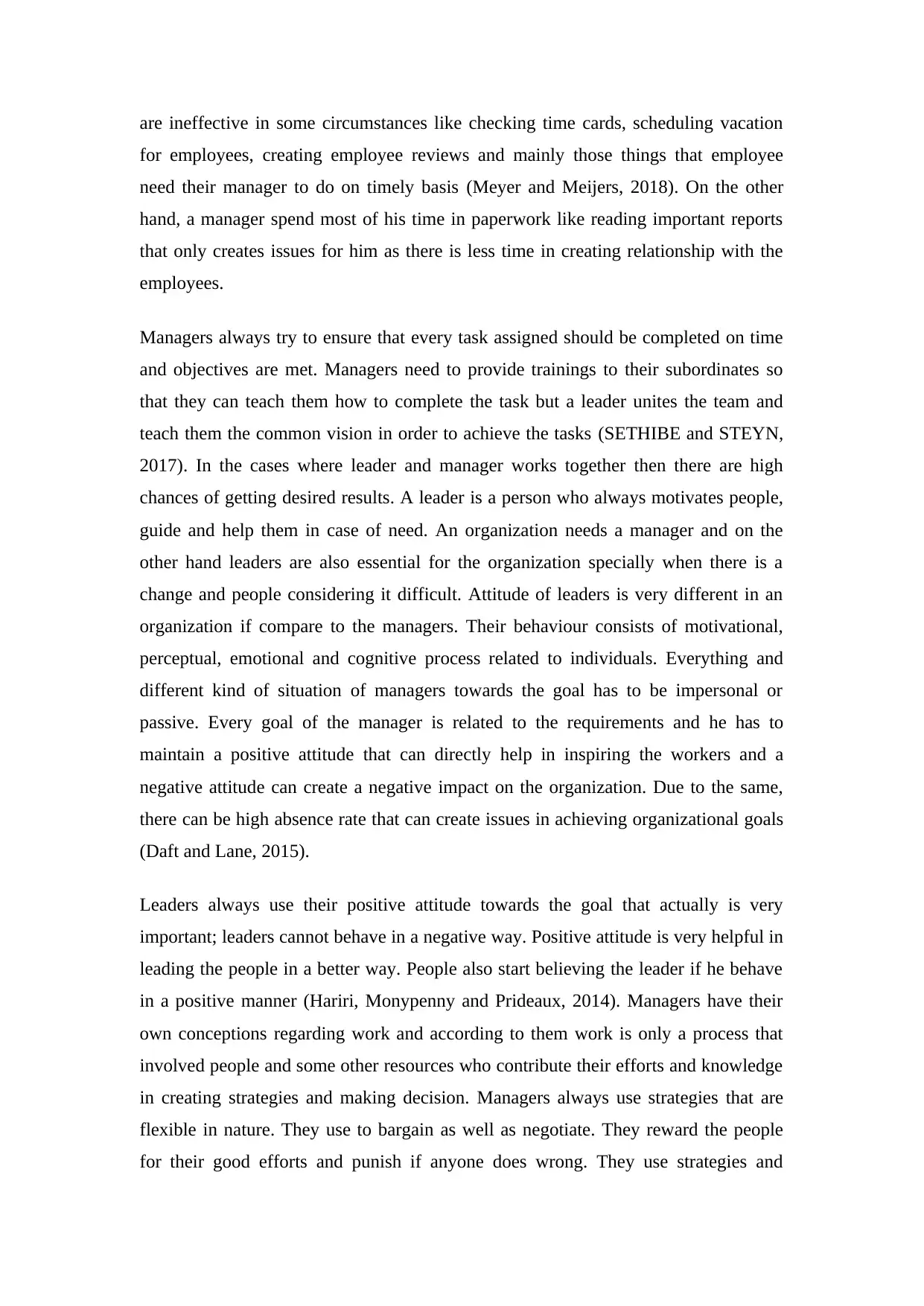
are ineffective in some circumstances like checking time cards, scheduling vacation
for employees, creating employee reviews and mainly those things that employee
need their manager to do on timely basis (Meyer and Meijers, 2018). On the other
hand, a manager spend most of his time in paperwork like reading important reports
that only creates issues for him as there is less time in creating relationship with the
employees.
Managers always try to ensure that every task assigned should be completed on time
and objectives are met. Managers need to provide trainings to their subordinates so
that they can teach them how to complete the task but a leader unites the team and
teach them the common vision in order to achieve the tasks (SETHIBE and STEYN,
2017). In the cases where leader and manager works together then there are high
chances of getting desired results. A leader is a person who always motivates people,
guide and help them in case of need. An organization needs a manager and on the
other hand leaders are also essential for the organization specially when there is a
change and people considering it difficult. Attitude of leaders is very different in an
organization if compare to the managers. Their behaviour consists of motivational,
perceptual, emotional and cognitive process related to individuals. Everything and
different kind of situation of managers towards the goal has to be impersonal or
passive. Every goal of the manager is related to the requirements and he has to
maintain a positive attitude that can directly help in inspiring the workers and a
negative attitude can create a negative impact on the organization. Due to the same,
there can be high absence rate that can create issues in achieving organizational goals
(Daft and Lane, 2015).
Leaders always use their positive attitude towards the goal that actually is very
important; leaders cannot behave in a negative way. Positive attitude is very helpful in
leading the people in a better way. People also start believing the leader if he behave
in a positive manner (Hariri, Monypenny and Prideaux, 2014). Managers have their
own conceptions regarding work and according to them work is only a process that
involved people and some other resources who contribute their efforts and knowledge
in creating strategies and making decision. Managers always use strategies that are
flexible in nature. They use to bargain as well as negotiate. They reward the people
for their good efforts and punish if anyone does wrong. They use strategies and
for employees, creating employee reviews and mainly those things that employee
need their manager to do on timely basis (Meyer and Meijers, 2018). On the other
hand, a manager spend most of his time in paperwork like reading important reports
that only creates issues for him as there is less time in creating relationship with the
employees.
Managers always try to ensure that every task assigned should be completed on time
and objectives are met. Managers need to provide trainings to their subordinates so
that they can teach them how to complete the task but a leader unites the team and
teach them the common vision in order to achieve the tasks (SETHIBE and STEYN,
2017). In the cases where leader and manager works together then there are high
chances of getting desired results. A leader is a person who always motivates people,
guide and help them in case of need. An organization needs a manager and on the
other hand leaders are also essential for the organization specially when there is a
change and people considering it difficult. Attitude of leaders is very different in an
organization if compare to the managers. Their behaviour consists of motivational,
perceptual, emotional and cognitive process related to individuals. Everything and
different kind of situation of managers towards the goal has to be impersonal or
passive. Every goal of the manager is related to the requirements and he has to
maintain a positive attitude that can directly help in inspiring the workers and a
negative attitude can create a negative impact on the organization. Due to the same,
there can be high absence rate that can create issues in achieving organizational goals
(Daft and Lane, 2015).
Leaders always use their positive attitude towards the goal that actually is very
important; leaders cannot behave in a negative way. Positive attitude is very helpful in
leading the people in a better way. People also start believing the leader if he behave
in a positive manner (Hariri, Monypenny and Prideaux, 2014). Managers have their
own conceptions regarding work and according to them work is only a process that
involved people and some other resources who contribute their efforts and knowledge
in creating strategies and making decision. Managers always use strategies that are
flexible in nature. They use to bargain as well as negotiate. They reward the people
for their good efforts and punish if anyone does wrong. They use strategies and
⊘ This is a preview!⊘
Do you want full access?
Subscribe today to unlock all pages.

Trusted by 1+ million students worldwide
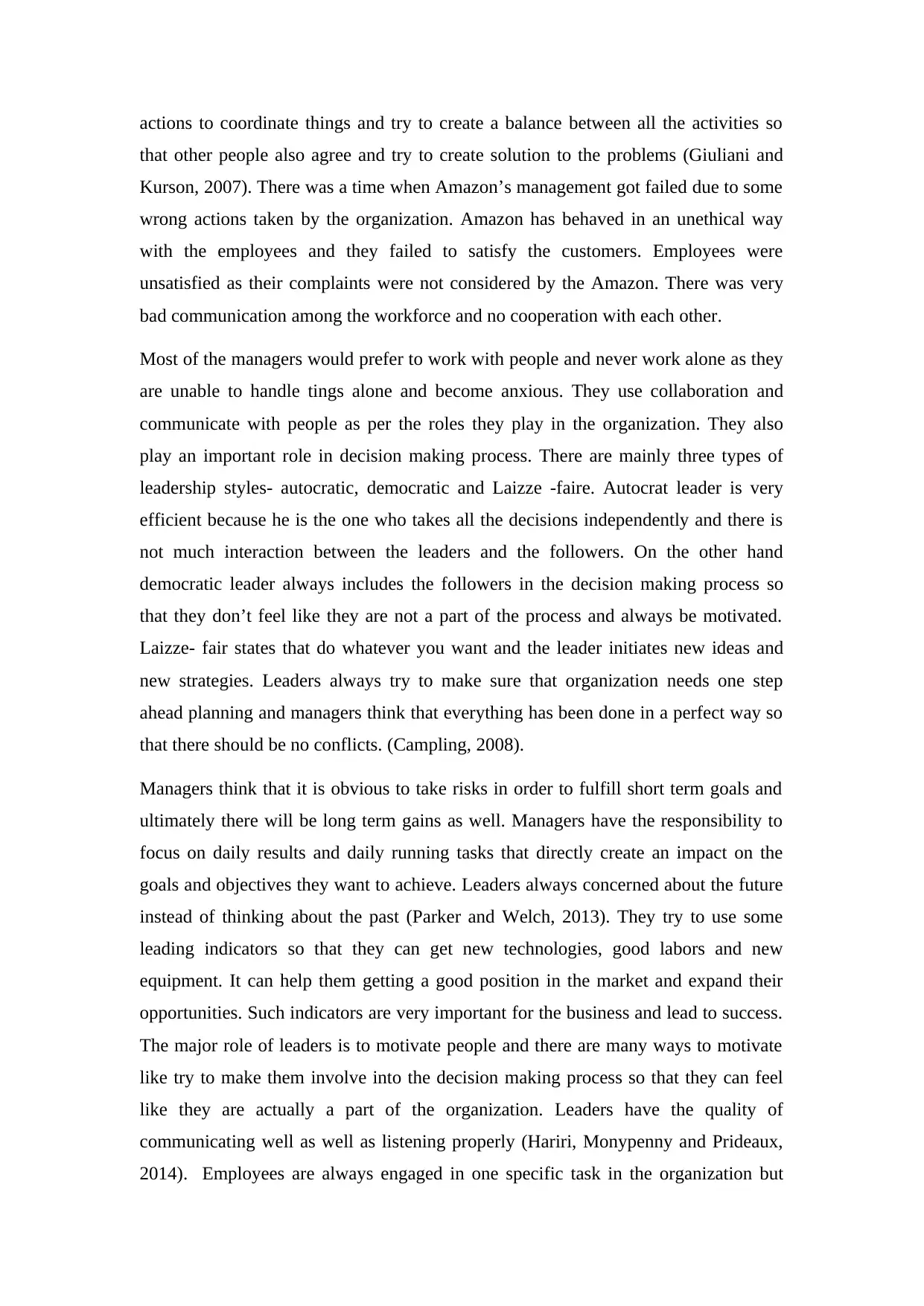
actions to coordinate things and try to create a balance between all the activities so
that other people also agree and try to create solution to the problems (Giuliani and
Kurson, 2007). There was a time when Amazon’s management got failed due to some
wrong actions taken by the organization. Amazon has behaved in an unethical way
with the employees and they failed to satisfy the customers. Employees were
unsatisfied as their complaints were not considered by the Amazon. There was very
bad communication among the workforce and no cooperation with each other.
Most of the managers would prefer to work with people and never work alone as they
are unable to handle tings alone and become anxious. They use collaboration and
communicate with people as per the roles they play in the organization. They also
play an important role in decision making process. There are mainly three types of
leadership styles- autocratic, democratic and Laizze -faire. Autocrat leader is very
efficient because he is the one who takes all the decisions independently and there is
not much interaction between the leaders and the followers. On the other hand
democratic leader always includes the followers in the decision making process so
that they don’t feel like they are not a part of the process and always be motivated.
Laizze- fair states that do whatever you want and the leader initiates new ideas and
new strategies. Leaders always try to make sure that organization needs one step
ahead planning and managers think that everything has been done in a perfect way so
that there should be no conflicts. (Campling, 2008).
Managers think that it is obvious to take risks in order to fulfill short term goals and
ultimately there will be long term gains as well. Managers have the responsibility to
focus on daily results and daily running tasks that directly create an impact on the
goals and objectives they want to achieve. Leaders always concerned about the future
instead of thinking about the past (Parker and Welch, 2013). They try to use some
leading indicators so that they can get new technologies, good labors and new
equipment. It can help them getting a good position in the market and expand their
opportunities. Such indicators are very important for the business and lead to success.
The major role of leaders is to motivate people and there are many ways to motivate
like try to make them involve into the decision making process so that they can feel
like they are actually a part of the organization. Leaders have the quality of
communicating well as well as listening properly (Hariri, Monypenny and Prideaux,
2014). Employees are always engaged in one specific task in the organization but
that other people also agree and try to create solution to the problems (Giuliani and
Kurson, 2007). There was a time when Amazon’s management got failed due to some
wrong actions taken by the organization. Amazon has behaved in an unethical way
with the employees and they failed to satisfy the customers. Employees were
unsatisfied as their complaints were not considered by the Amazon. There was very
bad communication among the workforce and no cooperation with each other.
Most of the managers would prefer to work with people and never work alone as they
are unable to handle tings alone and become anxious. They use collaboration and
communicate with people as per the roles they play in the organization. They also
play an important role in decision making process. There are mainly three types of
leadership styles- autocratic, democratic and Laizze -faire. Autocrat leader is very
efficient because he is the one who takes all the decisions independently and there is
not much interaction between the leaders and the followers. On the other hand
democratic leader always includes the followers in the decision making process so
that they don’t feel like they are not a part of the process and always be motivated.
Laizze- fair states that do whatever you want and the leader initiates new ideas and
new strategies. Leaders always try to make sure that organization needs one step
ahead planning and managers think that everything has been done in a perfect way so
that there should be no conflicts. (Campling, 2008).
Managers think that it is obvious to take risks in order to fulfill short term goals and
ultimately there will be long term gains as well. Managers have the responsibility to
focus on daily results and daily running tasks that directly create an impact on the
goals and objectives they want to achieve. Leaders always concerned about the future
instead of thinking about the past (Parker and Welch, 2013). They try to use some
leading indicators so that they can get new technologies, good labors and new
equipment. It can help them getting a good position in the market and expand their
opportunities. Such indicators are very important for the business and lead to success.
The major role of leaders is to motivate people and there are many ways to motivate
like try to make them involve into the decision making process so that they can feel
like they are actually a part of the organization. Leaders have the quality of
communicating well as well as listening properly (Hariri, Monypenny and Prideaux,
2014). Employees are always engaged in one specific task in the organization but
Paraphrase This Document
Need a fresh take? Get an instant paraphrase of this document with our AI Paraphraser

leaders believe in job rotation or some other methods like job enrichment and job
enlargement so that people can start taking more challenges and learn new skills. It
does not refer that managers are not responsible to motivate people; they also do the
same but in terms of finance like salaries increment, benefits and overtime allowance.
Most of the managers always think about the results and the performance of the
company and compare it with the past records and output produces. It helps in
analyzing the situation and the output produces as per the working hours of the
employees. They focus on profits as well. Managers try to provide fringe benefits to
the employees to motivate them. Although managers are not considered as great
motivators like leaders but yes leaders cannot motivate in terms of financial benefits
so that is also important for the success of the organization (Pietersen, 2016). Google
suggests some rules for good leader behavior and it includes-
Avoid micromanagement
Become a good coach
Helpful to employees
Focus on employee’s career development
Have a clear vision
Good communication and listening skills
Managers are supposed to follow some set of rules and regulation set by higher
management and is comfortable with bureaucracy while leaders always try to creative
as well as spontaneous. It clearly shows that a manager has to remain within some
boundaries of the organization and leaders always try to push such boundaries by
being proactive. It is a critical task for managing both of them in an organization and
there is a requirement to challenge the status quo to move forward but still there is a
requirement to follow a stable structure. This balance can only be achieved by the
leader and the manager both (Sax and Andersen, 2018).
Leader always help followers to be confident and learn positive things. There is
always a special bond between the leader and the follower that is missing in the case
of a manager. Manager always behaves in a very formal way but leader never do so.
Leader always involve the team in decision making process and each member feels
happy (Soerjaningsih, 2004). It is the major difference between the manager and
leader. Manager always concerned about the goals and wants to be ensuring if goals
enlargement so that people can start taking more challenges and learn new skills. It
does not refer that managers are not responsible to motivate people; they also do the
same but in terms of finance like salaries increment, benefits and overtime allowance.
Most of the managers always think about the results and the performance of the
company and compare it with the past records and output produces. It helps in
analyzing the situation and the output produces as per the working hours of the
employees. They focus on profits as well. Managers try to provide fringe benefits to
the employees to motivate them. Although managers are not considered as great
motivators like leaders but yes leaders cannot motivate in terms of financial benefits
so that is also important for the success of the organization (Pietersen, 2016). Google
suggests some rules for good leader behavior and it includes-
Avoid micromanagement
Become a good coach
Helpful to employees
Focus on employee’s career development
Have a clear vision
Good communication and listening skills
Managers are supposed to follow some set of rules and regulation set by higher
management and is comfortable with bureaucracy while leaders always try to creative
as well as spontaneous. It clearly shows that a manager has to remain within some
boundaries of the organization and leaders always try to push such boundaries by
being proactive. It is a critical task for managing both of them in an organization and
there is a requirement to challenge the status quo to move forward but still there is a
requirement to follow a stable structure. This balance can only be achieved by the
leader and the manager both (Sax and Andersen, 2018).
Leader always help followers to be confident and learn positive things. There is
always a special bond between the leader and the follower that is missing in the case
of a manager. Manager always behaves in a very formal way but leader never do so.
Leader always involve the team in decision making process and each member feels
happy (Soerjaningsih, 2004). It is the major difference between the manager and
leader. Manager always concerned about the goals and wants to be ensuring if goals

are met or not. Manager’s work is very challenging and difficult because they have to
achieve a goal in specific time and date. They also have to maintain routine tasks and
functions (Babiak, 2014).
Here it is concluded that “Leaders transform and Manager transact”. Leaders always
are the reason of transformation because the qualities and attributes of leaders
motivate followers and give them a feeling of ownership. Leaders treat followers in a
very different way and they can do so easily because they need not to follow any set
of rules and regulation. There are no norms that they have to follow while
communicating them and motivating them. On the other hand leaders have to transact
because they are involved into day to day process and have the responsibility to keep
a watch on daily task. There main focus always remains on the goals and objectives of
the organization. They only think about results and influence employees towards that
achievement of goals (Hariri, Monypenny and Prideaux, 2014). Managers have to
maintain a serious and formal relationship with every employee because they have the
responsibility to handle them in the most effective way. There are many differences
between a leader and a manager but it is known that they both are complementary for
each other. An organization needs a leader as well as manager for fulfillment of goals
and objectives.
References
Babiak, J. (2014). Polish Managers’ Leadership Styles: Developing and Validating the
Managerial Styles of a Leading Questionnaire. Polish Journal of Applied Psychology,
12(2), pp.41-63.
achieve a goal in specific time and date. They also have to maintain routine tasks and
functions (Babiak, 2014).
Here it is concluded that “Leaders transform and Manager transact”. Leaders always
are the reason of transformation because the qualities and attributes of leaders
motivate followers and give them a feeling of ownership. Leaders treat followers in a
very different way and they can do so easily because they need not to follow any set
of rules and regulation. There are no norms that they have to follow while
communicating them and motivating them. On the other hand leaders have to transact
because they are involved into day to day process and have the responsibility to keep
a watch on daily task. There main focus always remains on the goals and objectives of
the organization. They only think about results and influence employees towards that
achievement of goals (Hariri, Monypenny and Prideaux, 2014). Managers have to
maintain a serious and formal relationship with every employee because they have the
responsibility to handle them in the most effective way. There are many differences
between a leader and a manager but it is known that they both are complementary for
each other. An organization needs a leader as well as manager for fulfillment of goals
and objectives.
References
Babiak, J. (2014). Polish Managers’ Leadership Styles: Developing and Validating the
Managerial Styles of a Leading Questionnaire. Polish Journal of Applied Psychology,
12(2), pp.41-63.
⊘ This is a preview!⊘
Do you want full access?
Subscribe today to unlock all pages.

Trusted by 1+ million students worldwide
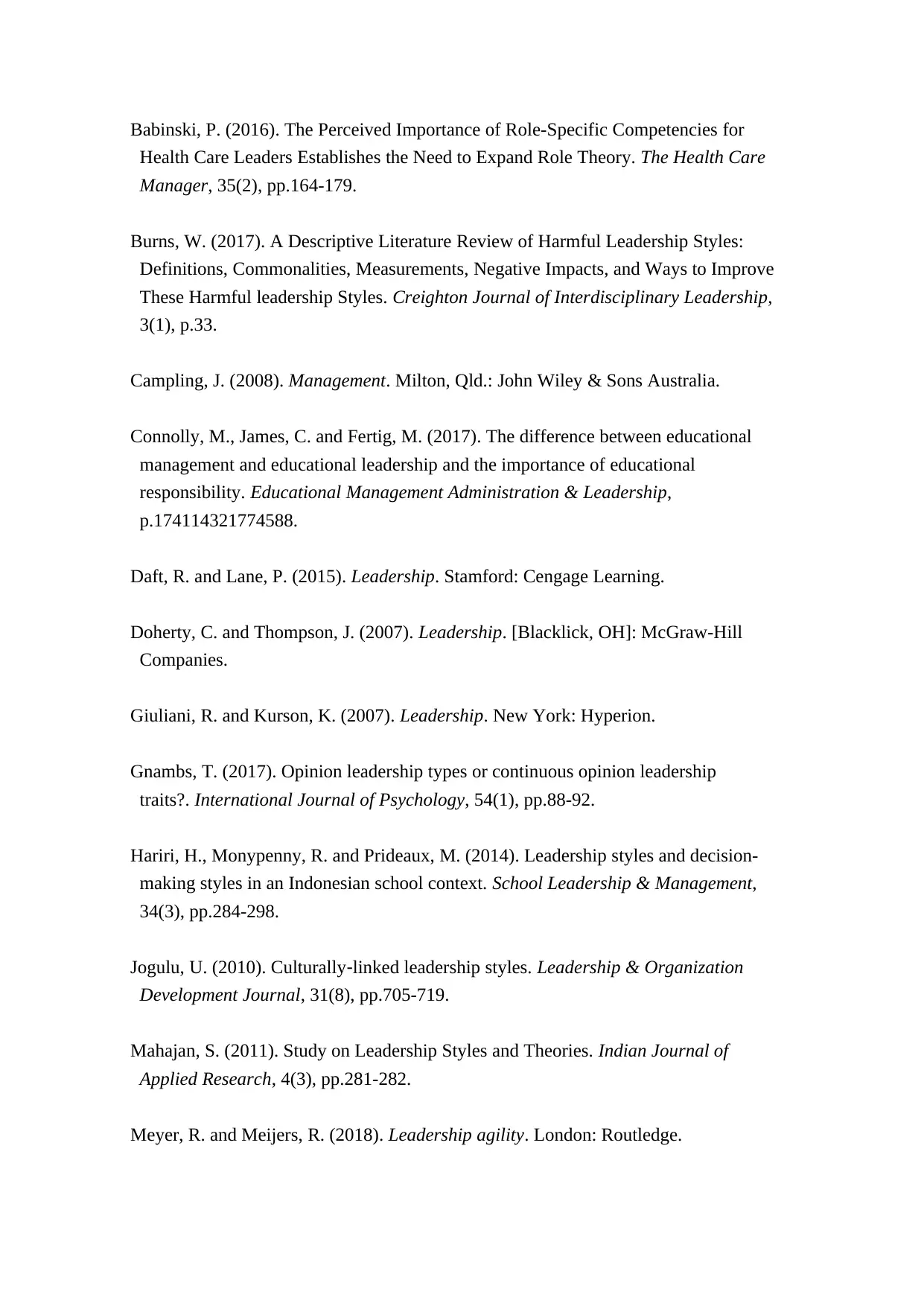
Babinski, P. (2016). The Perceived Importance of Role-Specific Competencies for
Health Care Leaders Establishes the Need to Expand Role Theory. The Health Care
Manager, 35(2), pp.164-179.
Burns, W. (2017). A Descriptive Literature Review of Harmful Leadership Styles:
Definitions, Commonalities, Measurements, Negative Impacts, and Ways to Improve
These Harmful leadership Styles. Creighton Journal of Interdisciplinary Leadership,
3(1), p.33.
Campling, J. (2008). Management. Milton, Qld.: John Wiley & Sons Australia.
Connolly, M., James, C. and Fertig, M. (2017). The difference between educational
management and educational leadership and the importance of educational
responsibility. Educational Management Administration & Leadership,
p.174114321774588.
Daft, R. and Lane, P. (2015). Leadership. Stamford: Cengage Learning.
Doherty, C. and Thompson, J. (2007). Leadership. [Blacklick, OH]: McGraw-Hill
Companies.
Giuliani, R. and Kurson, K. (2007). Leadership. New York: Hyperion.
Gnambs, T. (2017). Opinion leadership types or continuous opinion leadership
traits?. International Journal of Psychology, 54(1), pp.88-92.
Hariri, H., Monypenny, R. and Prideaux, M. (2014). Leadership styles and decision-
making styles in an Indonesian school context. School Leadership & Management,
34(3), pp.284-298.
Jogulu, U. (2010). Culturally‐linked leadership styles. Leadership & Organization
Development Journal, 31(8), pp.705-719.
Mahajan, S. (2011). Study on Leadership Styles and Theories. Indian Journal of
Applied Research, 4(3), pp.281-282.
Meyer, R. and Meijers, R. (2018). Leadership agility. London: Routledge.
Health Care Leaders Establishes the Need to Expand Role Theory. The Health Care
Manager, 35(2), pp.164-179.
Burns, W. (2017). A Descriptive Literature Review of Harmful Leadership Styles:
Definitions, Commonalities, Measurements, Negative Impacts, and Ways to Improve
These Harmful leadership Styles. Creighton Journal of Interdisciplinary Leadership,
3(1), p.33.
Campling, J. (2008). Management. Milton, Qld.: John Wiley & Sons Australia.
Connolly, M., James, C. and Fertig, M. (2017). The difference between educational
management and educational leadership and the importance of educational
responsibility. Educational Management Administration & Leadership,
p.174114321774588.
Daft, R. and Lane, P. (2015). Leadership. Stamford: Cengage Learning.
Doherty, C. and Thompson, J. (2007). Leadership. [Blacklick, OH]: McGraw-Hill
Companies.
Giuliani, R. and Kurson, K. (2007). Leadership. New York: Hyperion.
Gnambs, T. (2017). Opinion leadership types or continuous opinion leadership
traits?. International Journal of Psychology, 54(1), pp.88-92.
Hariri, H., Monypenny, R. and Prideaux, M. (2014). Leadership styles and decision-
making styles in an Indonesian school context. School Leadership & Management,
34(3), pp.284-298.
Jogulu, U. (2010). Culturally‐linked leadership styles. Leadership & Organization
Development Journal, 31(8), pp.705-719.
Mahajan, S. (2011). Study on Leadership Styles and Theories. Indian Journal of
Applied Research, 4(3), pp.281-282.
Meyer, R. and Meijers, R. (2018). Leadership agility. London: Routledge.
Paraphrase This Document
Need a fresh take? Get an instant paraphrase of this document with our AI Paraphraser
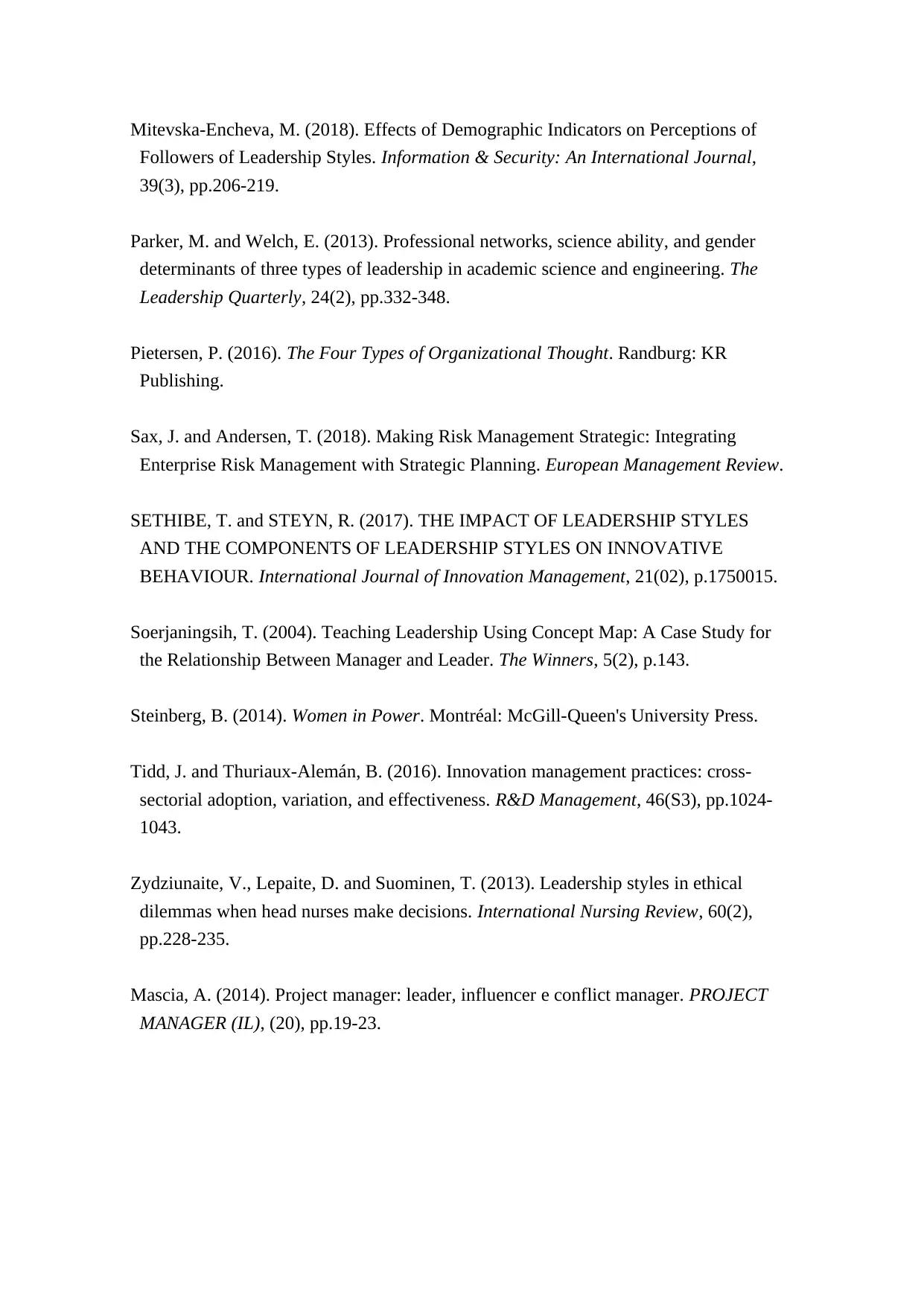
Mitevska-Encheva, M. (2018). Effects of Demographic Indicators on Perceptions of
Followers of Leadership Styles. Information & Security: An International Journal,
39(3), pp.206-219.
Parker, M. and Welch, E. (2013). Professional networks, science ability, and gender
determinants of three types of leadership in academic science and engineering. The
Leadership Quarterly, 24(2), pp.332-348.
Pietersen, P. (2016). The Four Types of Organizational Thought. Randburg: KR
Publishing.
Sax, J. and Andersen, T. (2018). Making Risk Management Strategic: Integrating
Enterprise Risk Management with Strategic Planning. European Management Review.
SETHIBE, T. and STEYN, R. (2017). THE IMPACT OF LEADERSHIP STYLES
AND THE COMPONENTS OF LEADERSHIP STYLES ON INNOVATIVE
BEHAVIOUR. International Journal of Innovation Management, 21(02), p.1750015.
Soerjaningsih, T. (2004). Teaching Leadership Using Concept Map: A Case Study for
the Relationship Between Manager and Leader. The Winners, 5(2), p.143.
Steinberg, B. (2014). Women in Power. Montréal: McGill-Queen's University Press.
Tidd, J. and Thuriaux-Alemán, B. (2016). Innovation management practices: cross-
sectorial adoption, variation, and effectiveness. R&D Management, 46(S3), pp.1024-
1043.
Zydziunaite, V., Lepaite, D. and Suominen, T. (2013). Leadership styles in ethical
dilemmas when head nurses make decisions. International Nursing Review, 60(2),
pp.228-235.
Mascia, A. (2014). Project manager: leader, influencer e conflict manager. PROJECT
MANAGER (IL), (20), pp.19-23.
Followers of Leadership Styles. Information & Security: An International Journal,
39(3), pp.206-219.
Parker, M. and Welch, E. (2013). Professional networks, science ability, and gender
determinants of three types of leadership in academic science and engineering. The
Leadership Quarterly, 24(2), pp.332-348.
Pietersen, P. (2016). The Four Types of Organizational Thought. Randburg: KR
Publishing.
Sax, J. and Andersen, T. (2018). Making Risk Management Strategic: Integrating
Enterprise Risk Management with Strategic Planning. European Management Review.
SETHIBE, T. and STEYN, R. (2017). THE IMPACT OF LEADERSHIP STYLES
AND THE COMPONENTS OF LEADERSHIP STYLES ON INNOVATIVE
BEHAVIOUR. International Journal of Innovation Management, 21(02), p.1750015.
Soerjaningsih, T. (2004). Teaching Leadership Using Concept Map: A Case Study for
the Relationship Between Manager and Leader. The Winners, 5(2), p.143.
Steinberg, B. (2014). Women in Power. Montréal: McGill-Queen's University Press.
Tidd, J. and Thuriaux-Alemán, B. (2016). Innovation management practices: cross-
sectorial adoption, variation, and effectiveness. R&D Management, 46(S3), pp.1024-
1043.
Zydziunaite, V., Lepaite, D. and Suominen, T. (2013). Leadership styles in ethical
dilemmas when head nurses make decisions. International Nursing Review, 60(2),
pp.228-235.
Mascia, A. (2014). Project manager: leader, influencer e conflict manager. PROJECT
MANAGER (IL), (20), pp.19-23.
1 out of 11
Related Documents
Your All-in-One AI-Powered Toolkit for Academic Success.
+13062052269
info@desklib.com
Available 24*7 on WhatsApp / Email
![[object Object]](/_next/static/media/star-bottom.7253800d.svg)
Unlock your academic potential
Copyright © 2020–2025 A2Z Services. All Rights Reserved. Developed and managed by ZUCOL.





